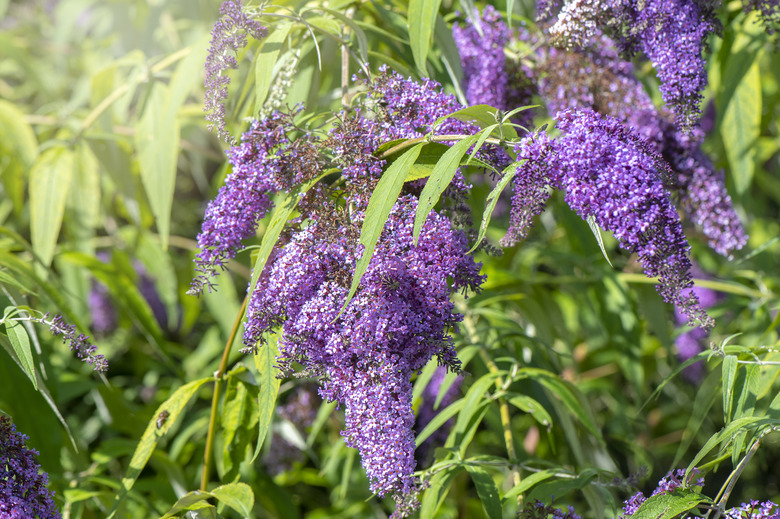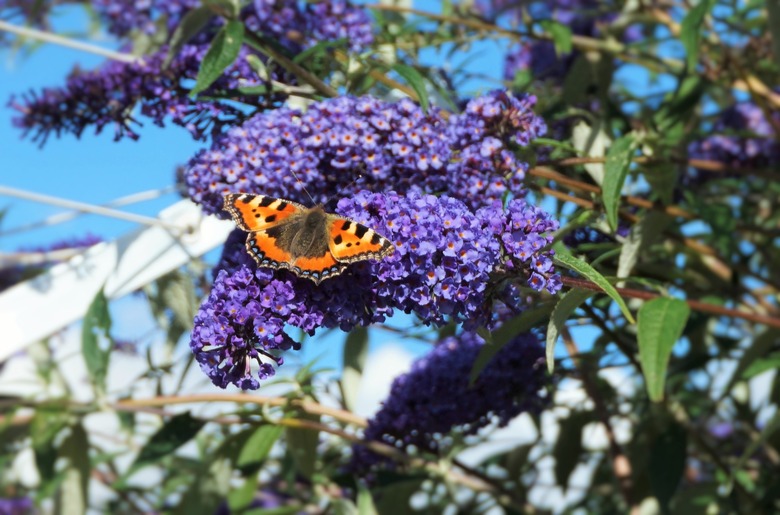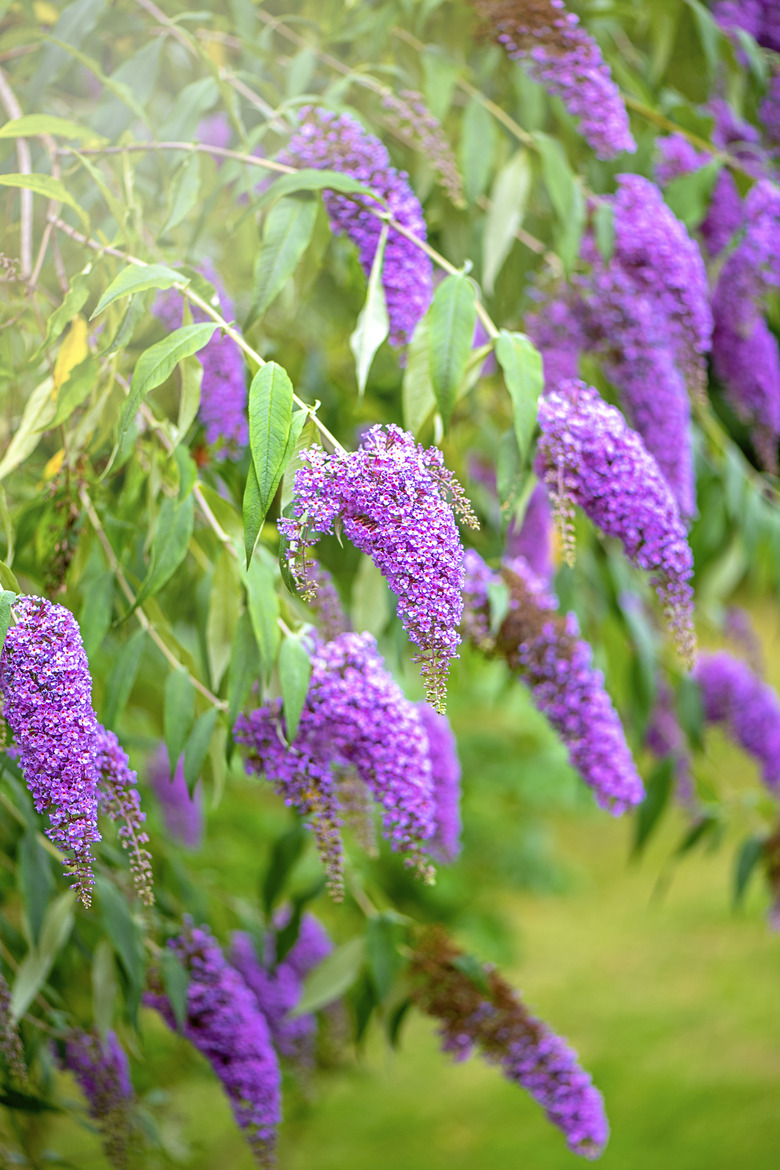How To Grow Butterfly Bush
We may receive a commission on purchases made from links.
- Best uses for butterfly bush
- How to grow butterfly bush
- In what zone does butterfly bush grow best?
- When should you plant butterfly bush?
- Soil, sunlight and water recommendations for butterfly bush
- How to propagate butterfly bush
- How to winterize butterfly bush
- Common pests and other problems for butterfly bush
- Common diseases for butterfly bush
The low-maintenance butterfly bush (Buddleja spp.) is a favorite for gardeners and butterflies alike, as it's showy and has a fairly long bloom time. This mildly fragrant deciduous to semi-evergreen shrub looks gorgeous in front of a window, as a focal point for a yard and is perfect for anyone who is interested in hosting a butterfly garden in their space.
Many butterfly bushes are excellent at self-seeding, allowing the wind to carry its seeds to other nearby areas. The end result often brings up new butterfly bush seedlings, which could be used for additional pops of color throughout the yard, although many species are considered weedy and invasive because of this trait. In some cases, the extra seedlings might mean extra work gardening to remove them if they sprout up in inconvenient places.
Best Uses for Butterfly Bush
Best Uses for Butterfly Bush
The butterfly bush is valued for its beauty and as a pollinator-friendly plant. With long, arcing blooms in shades from pale pink to dark purple or even yellow, red and white, it's hard not to notice a blooming butterfly bush as you walk or drive past one. Some people plant them specifically for their beautiful blooms that display at any time from June to September, while others aim to please the pollinator passersby.
Butterflies visiting the blooms are a special treat, especially if the shrub is planted near a window. While butterflies enjoy the nectar of the blooms, the butterfly bush is not a host plant for butterflies since it doesn't provide food for their young, also known as caterpillars. In other words, the butterflies won't lay eggs on a butterfly bush, as the caterpillars need a host plant that's a good food source for their needs as they grow.
Hummingbirds also appreciate the nectar from these blooms, so if you're quick enough to spot these elusive feathered beings, you may be in for a special treat as these plants often attract hummers in droves. Bees are also attracted to the butterfly bush, and they in turn are important to just about every neighborhood plant requiring pollination.
How to Grow Butterfly Bush
How to Grow Butterfly Bush
- Common Name: Butterfly bush
- Botanical Name:
Buddleja spp.
- When to Plant: Early spring, fall
- USDA Zones: 5-9
- Sun Exposure: Full sun
- Soil Type: Somewhat moist, well-drained soil
- When it's in Trouble: Overwatering may cause root rot, few flowers or plant dieback
- When it's Thriving: Produces numerous colorful blooms that attract butterflies and other pollinators
Starting Butterfly Bush From a Small Plant
Choose a location that gets plenty of sun and that has enough room for a butterfly bush to grow. Many varieties grow more than 6 feet tall and can spread up to 15 feet, although this generally won't happen for several years. Break up the soil in the chosen location and mix in some well-aged compost. Dig a hole about twice as wide and about as deep as the plant pot containing your young butterfly bush.
If you're planting more than one butterfly bush in the same general area, space the next hole about 6 to 10 feet from the first if your plant's variety grows tall or wide. Parts of a butterfly bush tend to sprawl outward and lean as they get tall, so positioning plants too close to one another could result in the branches from one plant spilling over into the next.
Carefully loosen the plant out of its starter pot by squeezing the sides of the pot. Tip the pot angled downward with one hand or with a friend's hands, catching the plant and its root ball as they come out of the pot. Set the plant upright in the hole so the top of the root ball is approximately level or even slightly higher than the top of the soil in the surrounding area, which creates a small mound that helps with drainage.
Fill the remainder of the hole with some of the soil you've removed, packing it down gently with your hands or your foot. It's best not to amend the soil in the planting hole at all before planting a butterfly bush, especially if the soil is a bit hard, as this could cause drainage issues.
Water the soil through so it's wet but not waterlogged. Optionally, top the area with an inch or less of mulch to keep weeds at bay while also helping the soil retain its moisture, especially if you live in a relatively dry area. Don't mulch if the soil has a claylike consistency. Throughout the growing season, water until the soil is damp but not soaked. Water the ground around the plant rather than the foliage.
In What Zone Does Butterfly Bush Grow Best?
In What Zone Does Butterfly Bush Grow Best?
Butterfly bush grows best in USDA plant hardiness zones 5 to 9, but some selections can be grown in zones colder than 5 as well. In colder regions, the plant dies back each winter. In zones 5 to 9, the butterfly bush starts its growth process again in spring, growing off old wood on the plant. In some states, some types of butterfly bushes are considered an invasive plant, so check your county's website or ask your local growers for rules regarding plant growth in your area. You can also purchase sterile — or mostly sterile — cultivars, which don't pose the same threat as their aggressive relatives.
When Should You Plant Butterfly Bush?
When Should You Plant Butterfly Bush?
A butterfly bush isn't entirely picky about when it's planted, but spring after the last frost is the best time or in early fall well before the first frost. Planting in spring or through the first half of summer ensures enough time for the plant to establish itself before the weather gets really cold.
These easy-care shrubs could be planted at any time between spring and fall, but the young plants may need extra watering and even some shade if planted in the hottest parts of summer in a warm climate. Planting on an overcast day helps the plant in hot weather, as it helps reduce the shock of transplanting.
Soil, Sunlight and Water Recommendations for Butterfly Bush
Soil, Sunlight and Water Recommendations for Butterfly Bush
The butterfly bush is a delight to grow for those who like low-maintenance plants, as it's not very picky about the type of soil or how often it's watered. Even clay-heavy soils generrally are not an issue for the butterfly bush. Like many flowering plants, however, it flowers and grows the most in full sun; it also tolerates partial shade with no issues. An area with six to eight hours of full sun per day on average is a good spot to plant a butterfly bush. Any spot with significantly more shade may reduce the plant's growth potential or the number and size of blooms it produces.
As far as watering is concerned, it doesn't take much effort to keep this plant happy as long as it's not sitting on soggy soil. In other words, don't overwater it to the point that its roots stay wet for long. If the plant sits in water, this could cause root rot, which may cause the entire shrub to die. This sometimes happens in cold climates since winter snow melts, and the ground is still hard. Too much moisture for an extended period of time is really the one major issue this plant faces regarding its growing conditions.
How to Propagate Butterfly Bush
How to Propagate Butterfly Bush
Divide a butterfly bush to plant parts of it elsewhere in early spring or in fall. Dig up a section of the plant after the soil has been watered enough to make it a bit softer. The clump should contain some roots and twigs or shoots of new growth. Plant the divided portion as you would a seedling and then pack soil into both holes to secure the plant sections.
Butterfly bush can also be propagated by cuttings from a healthy plant. In early to midsummer, choose a young, sturdy stem that's about 5 inches long and cut it below a bud using sanitized shears. Remove any leaves from the bottom third of the cutting. Dip the cut end in rooting hormone and then place the cutting in a small container of moist potting soil or a mix of equal parts perlite and peat moss, ensuring the pot has sufficient drainage holes in the bottom.
Keep the cutting in an area of bright light but out of direct sun, and water it enough that the top of the soil feels damp. In a month or so when the plant's roots give resistance when you tug on the stem, it's ready to transplant. A cutting is the most common way to propagate butterfly bush. Planting from seeds isn't a common practice, as it takes quite a long time to develop a shrub that produces flowers, which may not even resemble the blooms on the shrub from which you harvested the seeds.
How to Winterize Butterfly Bush
How to Winterize Butterfly Bush
While the butterfly bush doesn't generally need to be winterized, cutting back the spent blooms in fall is a good idea to help prevent the seeds from landing elsewhere in the neighborhood. Some types of butterfly bushes are considered a noxious weed in many areas, which means it is considered an invasive, non-native plant that disrupts the biodiversity of a region. In most regions, these plants are still offered for sale with encouragement to deadhead in order to keep the plants from spreading. Use sanitized shears to trim the stems on spent blooms just beneath the blooms.
In winter, prune a butterfly bush down to near the ground, which will help control its size for the next growing season. Once it is dormant in winter, use sanitized bypass pruners to cut the branches to several inches above the ground or a little higher if you prefer a taller plant. In areas that get extremely cold, several inches of mulch after pruning helps protect the plant from the cold.
Common Pests and Other Problems for Butterfly Bush
Common Pests and Other Problems for Butterfly Bush
Pests aren't typically a major issue for a butterfly bush, but in some cases, spider mites find this plant attractive, especially during dry conditions. Curled leaves or leaves with white or yellow spots on them are indicators of such an issue. To test the plant for spider mites, hold a piece of paper beneath one of the affected leaves and tap the leaf from the top. If you see small, dustlike specks that move on the paper afterward, these are spider mites.
Spraying the undersides of the leaves often loosens the mites, as they do not like water. Repeat this daily as needed. In the early morning is a good time, as this allows ample time for the plant to dry before dark, which also helps prevent fungal problems. Horticultural oils and insecticidal soaps sprayed on the leaves also reduce the mite population. Since products vary greatly, read the label thoroughly to determine how much product to apply and how often.
Common Diseases for Butterfly Bush
Common Diseases for Butterfly Bush
Although butterfly bush fares well in the average environment, root rot can be an issue in extremely wet conditions. If the plant seems to be dying or if the leaves turn yellow, root rot is likely the cause. It may be too late to save the plant, but in any case, do not water it until you're sure the soil dries out. Affected roots appear brown and soft rather than white and firm. Carefully dig around the roots; if the plant still has plenty of white roots, you may be able to salvage it by transplanting it to an area with good drainage. Trim away any rotten roots or portions of roots with sanitized shears before replanting the butterfly bush. Discard the damaged roots.
References
- Missouri Botanical Garden: Buddleja davidii
- The Old Farmer's Almanac: Growing Butterfly Bush
- American Meadows: How to Grow Butterfly Bush
- CAB International: Invasive Species Compendium: Buddleja davidii
- Proven Winners: The Proven Winners Ultimate Guide to Butterfly Bush
- Walter Reeves: Butterfly Bush – Spider Mite Control
- Missouri Botanical Garden: Spider Mites – Outdoors
- King County: Butterfly Bush Identification and Control
- Nature Hills Nursery: Butterfly Bush Pruning
- Pennington: How to Identify, Fight and Prevent Root Rot


